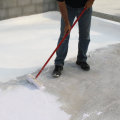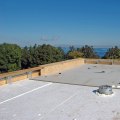The first thing to consider when it comes to flat roofs is that, if installed correctly with top-of-the-line materials, they can last between 20 and 25 years. The exact lifespan of your flat roof depends on the type of flat roof material you choose. For example, a flat membrane roof can last 25 to 30 years, depending on the type you select. Specifically, a flat TPO membrane or PVC membrane cover should last around 25 years.
On the other hand, an EPDM roofing membrane is more durable and can last between 25 and 30 years. If installed properly, a flat roof can last up to 20 years. The lifespan of a flat roof is determined by several factors, such as the quality of the roofing materials and how well it is maintained. Sealing your flat roof is an essential part of protecting it from the elements and extending its longevity.
In general, a good quality flat roof should last about 10 years, but with the right coating, it can last much longer. Sealing is a great way to extend the life of your flat roof and reduce the number of repairs you may need. But how often should you seal your flat roof? The age of a flat roof is often an important factor in determining when it needs to be replaced. Flat roofs usually have an average lifespan of 15 to 30 years, depending on the materials used and the quality of the installation.
Regular maintenance and inspections can prolong this lifespan, but beyond a certain point, repairs become less cost-effective than a complete replacement. Determining when to replace a flat roof involves considering multiple factors. Regular maintenance, evaluation of age, major damage, concerns about energy efficiency, changes in building use or regulations, and future plans all play an important role in making the right decision. If you notice your roof starting to crack or chip, it's time to replace it.
Cracking and chipping problems are common on BUR flat roofs. These problems can be caused by several different factors, such as exposure to heavy rain, wind, or hail, and temperature fluctuations. Cracks and chips can create problems in the roof, such as allowing water to seep through and causing leaks. This can lead to costly repairs and can even cause the roof to break.
Regular roof maintenance and inspections can help identify and repair any problems before they become serious. Proper roof installation can help reduce cracking and chipping problems in the future, but spray foam ceilings are the best solution for flat roofs. This seamless waterproof layer eliminates problems resulting from expansion and contraction that allow water and microbes to seep in and damage the roof. This can lead to a variety of problems, including water damage, mold, and structural damage.
To avoid these problems, it's important to take proactive steps to ensure that flat roofs are properly sloped, have adequate drainage, and are regularly sealed and maintained. In addition, installing a waterproof membrane layer can help protect the roof and the house from any accumulation of water. Taking these precautions can help ensure that your flat roof is airtight and avoid any major problems over a period of time. However, BUR roofing systems will begin to fail after 10 to 15 years and will need to be removed and replaced with new roofing material.
This can be avoided by installing a foam roof which only needs to be covered every 20 years to keep it working like new. Conventional BUR roof systems for flat roofs have joints that over time due to expansion and contraction begin to separate and allow water and microbes to seep through and damage the roof. BUR roofs also use joint covers at the intersection between walls and other roof features such as chimneys, pipes, skylights or compressors. The gasket cover is designed to waterproof these areas but unfortunately due to expansion and contraction improper installation or degradation over time gasket covers lose their integrity and adhesion.
Once the seal starts coming off moisture and water begin seeping into the roof structure causing leaks. Curly edges occur when roofing material is exposed to extreme temperatures which causes the edges of the material to curl up. This is a common problem on flat roofs as they are more exposed to the elements which can cause water pooling leading to more serious damage if not treated promptly. On average a residential or commercial structure's flat roof needs replacing after about 15 years although this may vary depending on materials used as well as maintenance schedule followed.
If you're a building manager owner or caretaker of a building it may not always be immediately apparent that your flat roof requires attention. If you want to avoid problems with roof leaks Armstrong foam ceiling systems are ideal as they offer low prices for good reason plus I guarantee your flat roof won't reach its maximum lifespan without them. Replacing a flat roof is an important task but it's important to preserve its integrity by taking proactive steps such as ensuring proper drainage sealing regularly maintaining moisture levels using waterproof membranes as well as installing foam ceilings. Sagging problems are avoided with SPF ceilings which are not only durable but also lightweight plus re-roofing without removing damaged materials is possible by adding another membrane such as EPDM or TPO over existing one.
Curly edges caused by extreme temperatures are prevented by avoiding pooling water which leads to more serious damage if not treated promptly. In conclusion regular maintenance inspections sealing waterproof membranes foam ceilings re-roofing without removing damaged materials avoiding pooling water all play an important role in preserving integrity of your flat roof while extending its lifespan.



